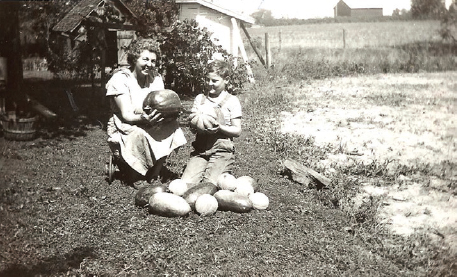
PLANTS JUST GROW BETTER when you start them yourself from seed. Seeds find their way into cracks and crannies, then grow into flowing masses, weaving the world together in ways we gardeners could never, ever coerce any potted plant into doing. I cherish a strappy old crinum that seeded in at the bottom of a cylindrical cactus, throwing its arms and leaves into a big embrace of its spiny friend. Almost every gardener I know has a shared memory of grandparents who grew all their food from carefully selected vegetable seeds. Some have family heirlooms like a tomato seed brought over from Poland and passed down. Some have family traditions, like winter days spent coordinating who gets what from the seed catalogs. It’s a weird state of affairs that growing things from seed today has become a rarity; not too long ago, it was the way everybody started gardening. What were the first seeds you collected and planted? Mine were marigold seeds, “stolen” from the nuns’ garden at my elementary school. I’d fill up my lunch box and sow the seeds along with daddy’s germinating squash.
My thesis advisor and friend, John Wott, grew up on an Indiana farm where growing diverse crops from seed was a way of life. Here, he and his mother proudly show off their melons.
Older gardeners, by either necessity or philosophy, tend to garden from seed. Many of my mentors share the seed obsession, which bridges all plant specialties, be they vegetable, camellia, cycad, or zinnia lovers. They cherish loquat, camellias, or lime trees grown from seeds saved from making gin and tonics, and they save little pots for things yet to germinate. They have bags of peas in the fridge, stray beans in their key dishes, and a big, hard, black thing rolling around the floorboard of the car—something they picked up outside a motel in Texas. They save seeds, money, and memories with those plants. They start whole gardens from seed or let whole gardens seed themselves in.
My grandfather had a garden—two, really. All around the perimeter were azaleas, gardenias, a huge pomegranate tree, and a palmetto he’d grown from seed picked up on the beaches of Hunting Island, South Carolina. In one sunny oval bed in the middle, mixed together, he grew summer vegetables and flowers. He taught me to save annual red salvia in a paper sack—just cut off the old flower heads, drop the whole thing in, wait a few days, and shake. You’re left with a bag of leather brown seed on the bottom and easy-to-discard trash on the top. It’s all so simple, and free. Still, it never fails to amaze me how many people I meet, professionals included, who have either never seen anyone do this, or are surprised and charmed that I do. I often do it in whatever bag is lying around in the floorboard of the truck. In the process, I am recycling, prepping for next season, and reviewing memories of my bald, old “Grangran” all at the same time. Sweet, isn’t it?
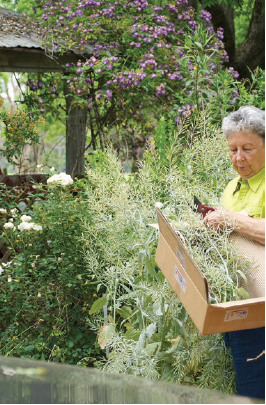
Mustard seeds stored in a paper bag or cardboard box will dry, and then can be cleaned from duff with just your hands and a little wind. Here, my mother collects some in a box.
Seeding in and letting things go to seed helps us recognize the larger cycles of plant life; you may even get a wonderful new plant due to genetic variation that comes with sexual reproduction. And, as a bonus, it sure cuts out a lot of the compulsive work of deadheading. In fact, with some seed-in plants, the most important thing you can do is to just give up any idea of control. Larkspur can really be a pain, coming up and covering even midsize roses; Jewels of Opar sprouts in the cracks between bricks; and you can hardly get rid of four-o’clocks. Yet I love them all as much as goldfinches love crepe myrtle seeds in the winter. Even if they make too many of themselves, I’d rather garden by pulling out, by editing, than by adding new little plants that need encouragement to fill in.
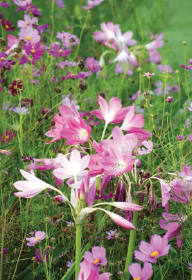
Common summer annuals like red salvia or the pink cosmos that seed in around these ‘Bradley’ crinum lilies are easily collected by putting the entire flower stem in a bag.
The cycle, however, depends on getting a good start. Start with great seeds, and you’ll have good plants forever. Collecting seeds from your friends and neighbors works great, so if you see something you like, save the seeds. But if you’re going to buy seeds, be sure that they’re great seeds—though, getting your hands on them is a bit harder than you might imagine. With flowers, it’s easy enough, though I suppose not as crucial; but with our vegetables, political history, modern science, and profitability have influenced what you can get ahold of. As one of our teachers describes, regulations led by the singular motive of profit left home vegetable gardeners with little choice in quality seeds.
Due to changes in our eating and nutrition habits and bodies, it’s critical that you start with and always use great vegetable seed. One great way to do that is to buy flower, tree, or vegetable seeds from seed saver catalogs. It’s always fun to get them in the mail every winter, and you can buy seeds that carry on the stories and histories of their collectors. But with a little work and time, and by applying some simple methods, saving your own seed results in your own seed strains—you can write your own stories, associating plants with your own family, friends, or special places from your past. Gardening from seed gives us control, and as the teachers in this chapter will tell us, we need to be aware of the quality of flowers, veggies, and all kinds of seeds in your garden. Gardening from seed is essential and efficient for veggie gardening, and it’s a soulful recognition of the cycles of life.
The Teachers
ROY OGLE AND DAVID BRADSHAW
Where do new vegetable seeds come from? For every seed you buy, some farmer had to have a field of plants and care for and harvest those seeds. Seed breeding is a huge industry that is constantly embroiled in politics and drama. For sixty years, Roy Ogle and David Bradshaw, both now retired from Clemson University, have been in the middle of it all. The industry has changed drastically over the past few decades. From a homeowner standpoint, the entire vegetable seed industry is sort of frozen in time; they’ve basically stopped making new seed varieties, and the choices of old ones get fewer and fewer. Without going to specialty sources, you literally cannot get the quality or the variety of seeds that our grandparents bought at the feed and seed store. Since the late 1960s, changes in genetic manipulations, public policy, and politics have made it really difficult for home gardeners to buy improved seeds.
“If you buy a little seed pack at a big retail store, you just don’t know what you’re getting inside,” says Dr. Roy Ogle, and he should know. His achievements in classic seed breeding include not just one, but every common southern pea that we eat today. And if you eat a sweet potato in the South, it’s all thanks to him. Dr. Ogle developed ‘Cherokee’ sweet potato, the forty-year standard for agriculture and cooking. He spent ten years working with pathologists to breed the perfect yam—disease resistant, tasty, easy to propagate, grow, store, and transport. This is a man who was part of the generation that set the standard for the vegetables that we eat today. He and his colleagues’ golden days were in the 1950s and early 60s. Working in fields and labs with taste testers, nutritionists, and plant and health scientists from around the world, they bred every common vegetable that we eat today. They studied plants from all over the world. They’d find, say, a really sweet potato in CuyoCuyo, Peru, and they’d beg for, borrow, or just steal it. Then with little paintbrushes, bags, and real plant sex, they’d cross that potato with a heat-tolerant one from a garden in Miami. After years of fieldwork, they’d have a better sweet potato for your grandparents’ farm and table.
Until the mid-1960s, most vegetable breeders were employed by universities with the goal of producing plants that suit the farmer and the homeowner. In this photo from the State Archives of Florida, Harold Zarse monitors controlled breeding of corn in Florida.
But two things changed, making them the last of their breed. First, they were trained and working as classical geneticists, working with plants in the field and hybridizing through sexual reproduction. But in the mid-1950s, molecular genetics was born, and hybridization moved into a lab, under a microscope, eventually turning into the genetic modifications we hear so much about today. Second, the push toward profitability (above all else) slowly reduced the funding for public research in plant breeding. As many of them retired or died, they simply weren’t replaced, but their vegetable varieties are still the best for home gardeners.
Breeders like Dr. Ogle were stewards—scientists in public service, commanding complex research programs with two equally important audiences: farmers and homeowners, agricultural industry and backyard gardeners. Old-style seed breeders served both. From Purdue, Santa Cruz, and Beltsville, Maryland, they developed seeds that became the food we eat everyday: yellow corn, white corn, pickling cucumbers, slicing cucumbers, green peas, wax beans, watermelons, carrots, beets, and, of course, tomatoes. Almost all came from the public agricultural colleges of each state.
The 1970 Plant Variety Protection Act moved vegetable seed breeding almost completely into the private sector. According to Dr. Ogle, “This was a mistake. It really hurt our public seed breeding, and things have been downhill ever since.” Here’s one simple example: I know of a collection of cantaloupe seeds that one of these breeders amassed over the years. It represents decades of collecting the best genetic potential that could be used to breed resistance to leaf diseases into the vines. After this breeder retired, no one picked up the project, and eventually, all the seeds were destroyed. Those seeds, his work, and the potential for a humidity-tolerant, nutritious melon that could be grown both in your backyard and on commercial melon farms are gone. Since home gardeners represent a small market for seeds, the dual mission of public seed breeding programs has been lost. Today, melons are bred only for the West Coast and for Texas and Florida winter production, simply because that’s where the money is.
Here’s one more short example a friend sites. The faculty at University of New Hampshire bred the best watermelon for the Northeast, ‘New Hampshire Midget’. Since it matures quickly in a season, home gardeners in cool climates can grow watermelons. As my friend says, “It will be a cold day in hell (or a hot day in Concord) before a small state like New Hampshire pays a career faculty to do something like that again.”
However, for farmers, Dr. Ogle stresses that the seed companies can and still do great work: “The science is still there, the private companies do wonderful, complex work to create diversity and new crops.” But that major difference means you have to work harder than ever to get great seeds: “They [private companies] develop strictly for the big farm growers,” Dr. Ogle says. “To my knowledge, there are no improvements being made for homeowners’ specific needs—maybe a handful of very small companies.” When I ask him how much this has changed since his time, he says,
Even politicians insisted we [breed for homeowners]! We had demonstration days for home gardeners and financial support for breeding vegetables adapted to home and farm. The first time we put on a home demonstration day, gosh, we must have had 2000 people who came to see the differences in ‘Big Boy’, ‘Better Boy’, and ‘Whopper’ tomato and all the different, much improved southern pea varieties.
Today “the companies just aren’t interested at all,” he says. They have other priorities. Think of it like this: if PBS were to lose all funding, then profit-oriented companies would be our only choice in news. If the federal government didn’t set efficiency standards, we’d still be in cars that got 6 miles to the gallon. Public good seldom motivates industry. To illustrate how much things have changed in the seed breeding industry, during our conversations, Dr. Ogle asked me about our family’s “seedsman” in Beech Island, where I grew up. Just hearing that simple question and realizing how much that concept has vanished over the years was telling.
I still think back fondly on going to Simpkins’ Seed Co. with my daddy. The floor was made up of unpainted and worn boards with just dirt, hay, and rat pellets in between. Men waited around to carry the heavy bags, surrounded by a hundred cats, baby chicks, and rabbits, all while cigar smoke and the pink dust of fungicide that coated corn seeds wafted through the air. Across the road was a then modern “variety store,” Sky City, and nearby was the Art Deco S & S Cafeteria. But Simpkins’ was all 1950s—in some ways, maybe even 1850s. It was mostly feed and fertilizer, but there was a bar in one corner with a glass counter with scales and little paper seed sacks. Behind it there were shelves stacked with big glass jars full of seeds for the season. Once he helped you decide what you wanted to plant, Mr. Simpkins poured seeds onto the glass bar. With his thick fingernails, he raked lines through a spill of seeds of, say, ‘Black Seeded Simpson’ lettuce, ‘Clemson Spineless’ okra, ‘Charleston Gray’ watermelon, and ‘Kentucky Wonder’ bean, then put them in crisply folded brown paper bags—tiny ones for backyard growers, bigger ones for farmers.
Mr. Simpkins helped you figure out which variety would perform best for you, which one stored longest, canned easiest, or suited the taste of your family. These days, this might all sound old fashioned and backward, but I sure do miss him being nearby—and you probably do, too, even if you’re not aware of it. Now I have to go pretty far out of my way, but I’ll drive deep into the country to find a good seedsperson. If you live in a progressive, hip town, you might even run into an updated version of the old-fashioned feed and seed, now a kind of boutique, complete with maybe a coffee bar. I’ve been charmed and bought great seeds in downtown Seattle, Ann Arbor, and the suburbs of Dallas.
When it comes to growing from seed, Dr. Ogle says, you have three options: “If you want a great garden, find a seedsman to help you pick the seeds. Or a specialty catalog of heirloom seeds.” The third option, then, is to save your own seeds. That’s what Dr. Ogle has done for years: “I save all my seed. It’s easy and sure. Especially the self-pollinated peas,” his favorite incredibly productive and nutritious crop. Dr. Ogle uses the same old technique my grandfather used with his red salvia: “I just pull the best-looking pea plant, the most productive, put the whole thing inside in a bag, the seeds fall off inside, and I save those seeds.”
Dr. David Bradshaw, another professor emeritus from Clemson University, is the man who inspired my love of old gardening styles. He’s a hippy-turned-academic who loves moss, homemade fruit wines, and being naked in the woods. Dr. Bradshaw is a force—a storyteller and a nurturer; a man who knows himself, who believes deeply that we all need to save our own seeds, even if only to pass on these memories to new generations. As director of the South Carolina State Botanical Garden, he built a 2-acre organic veggie research trial garden. He did this in the early 1980s in Clemson, South Carolina, an era that was about as conservative and closed-minded as you can get. Dr. Bradshaw challenged it all; he brought sustainable gardening and heritage seed saving to the people of South Carolina. I was an agriculture student at the time, with three earrings and a yellow mohawk. My classmates and I saw ourselves as rebels, and Dr. Bradshaw’s gardening stance was brave, rebellious, and inspirational to hundreds of students like myself.
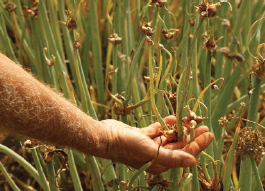
Dr. David Bradshaw refers to seed saving as memory banking. Lots of people can grow this same onion, but he and his family call it “Momma Sudie’s Onion,” and they all think of her when they grow or eat it.
Dr. Bradshaw started a seed bank by asking the older folks in the foothills of the Appalachian Mountains to share their heirloom seeds. “But they all said they didn’t have any!” he says. “So I’d kick around and chat and see a jar of peas and ask about those only to be told they were nothing special, just something my Grandma kept for years. So here’s an 88-year-old man, telling me he has the same seed as his grandmother. But he doesn’t have any heirlooms.”
“Everyone can have heirlooms,” says Dr. Bradshaw. “And you don’t have to be old or poor or from the mountains! Sometimes, I call seed saving ‘memory banking.’ It’s a way to keep stories of people and family events. We have an old-fashioned Egyptian Walking Onion in my family. Common old plant, lots of people have the same thing. But we call it Momma Sudie’s Onion; everybody in the family knows what that is and thinks of her when we talk about it.” Heirlooms offer flowers, too. Dr. Bradshaw’s garden holds a crinum lily that he dug fifty years ago in North Carolina. Its striped flowers open every June. And on his fence, purple hyacinth bean, while edible, is actually grown for its grape soda–colored flowers and lacquered beans; it’s a commonly shared plant.
With time—and it doesn’t take long—some heirlooms have become unique. Dr. Bradshaw says that in just sixteen generations of selecting for a special characteristic, you can create a unique plant. That’s, at most, just sixteen years, and only six to eight if you’re working diligently.
Seed saving is especially easy with closed-pollinated plants (otherwise known as self-pollinated). These are the easiest to work with and still be sure you’ll get the same thing from year to year. In other words, once you select something, it’s not going to change much over the generations. Billy Pop Fowlkes is an old Virginia farmer, now in his late eighties, who grew up on a small tobacco farm in the rolling hills of central Virginia, near Farmville. He recollects, “We put black-eyed pea plants in burlap bags in the barn, in winter. When you wanted to eat peas, you whack the bag and whack it, with a pole, get the peas and clean the trash out in the wind. We’d eat some. What was left was seed for next spring.” His black-eyed peas, over eight to ten years, adapted to being whacked in burlap bags and slowly became the best variety for his farm. And they most likely saved the seeds of only the most vigorous and tasty plants. But his next comment goes a long way in showing how the culture of seeds has been changed by modernity: “But when frozen peas came around, they seemed just as good; the years of selection got lost.” The frozen peas only seemed just as good because you didn’t have to whack them or store them in the barn. So Billy Pop and his family, like many small farmers, quit saving seeds, inadvertently losing a bit of history as well as a locally adapted pea.
If you buy a pack of seeds and want to know if they are open pollinated, you can just look them up online. For vegetables, however, that information is usually provided on the package or in the seed catalog. Seed saving is more difficult with open-pollinated plants, as characteristics that you may like of a certain plant are apt to be lost in future generations. On the other hand, the unpredictability means that a new surprise awaits you each season. For example, if you lived in Charleston in the 1950s and grew Charleston Gray Watermelon, and then sent seeds to your brother in Indiana, who grew them for years, saving the seed each winter, he would ultimately grow a different watermelon. Soil, water patterns, insects, and climate all differ, and within a few summers, your brother wouldn’t really have Charleston Gray anymore. If he sent seeds back to you in Charleston, and you grew those out, you might think, “this isn’t at all what I remember”—that’s called genetic drift.
Something else was lost in this transition. Before those frozen peas hit the shelves, we also selected for taste, texture, and “mouth appeal” on a very local level. Those long-saved peas of your grandparents really did taste better than peas that look the same today. As Dr. Ogle alluded to, vegetable selection used to take under consideration the home gardener’s needs and likes, such as fresh taste, whereas now, private breeders select for shipping, storage, uniform harvest time, and all the things that play into getting peas from the field to the freezer efficiently. Still, with certain plants, those that are closed pollinated like peas, we can easily change them, save the seeds, and readapt them to our taste, climate, and needs.
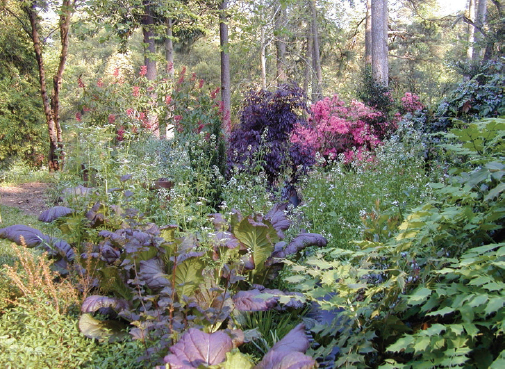
Even vegetables and herbs such as peppers, basil, mustard, and radish will seed in if you’ve used old fashioned varieties and let them go to seed in the garden. Here, mustard and arugula volunteer.
This sort of seed saving became the norm for many small farmers and home vegetable growers. While we’ve certainly lost touch with these practices, of very slightly altering our own plants with just a little bit of care and experimentation, there is a growing renewed interest, and a new crop of seed saver and heirloom seed banks. Our National Center for Genetic Resources Preservation in Fort Collins, Colorado, is one of the largest seed facilities in the world. And there are smaller specialized organizations that maintain seeds of various interests (the seeds of Thomas Jefferson and of the Cherokee Nation, for example); there are even specialized tobacco and marijuana seed banks. It is critical for us to continue to save our own seeds and to support these groups and companies. The genetics of those old seeds really were developed with the intention of ensuring that you could have a nutritious, successful garden in your backyard. And the stories of heirloom flowers feed our souls and memories of gardeners past. The old timers took part in the process out of necessity, out of their understanding of adaptability. We need to heed their call, because our doing it helps us understand that better, too. It helps us develop new seeds for our new and changing climates, and it’s the most basic, inexpensive, and sublime kind of gardening you can do.
Updates and Adaptations
As a gardener, I do save seeds constantly, but I’m not very organized. I save them in bags and boxes and envelopes, in drink cans, and in some really old film canisters. One drawer of the fridge, a basket on the porch, underneath the truck seat, and coat pockets are all dedicated storage places. We all have our own little ways, places, and habits for storing seeds. But I even save seeds in the ground, a technique all gardeners interested in seed saving should consider. On the farm, Tom and I encourage plants whose seeds come up in the fields year after year. We also do things in a more systematic fashion that leads to fun hybrids and to cool new crinum lilies.
One of the easiest ways to save old plants by seed is simply to garden in ways that build up a seed bank in the ground. Let things go to seed so they’ll come back on their own next season. Now, this may seem like a complicated way of saying that I just do nothing, but, the truth is, the process does take some self-monitoring. But you must abstain from some of our most common, modern gardening habits.
In other chapters, we’ve seen how some modern gardening techniques can stop the seed-in cycle. Deadheading is one of those modern ideas that compromises the soil seed bank. Though it seems elementary, in order to save seeds, you have to let things go to seed. Many gardeners have an obsessive tendency to deadhead, to tidy up, pull up, and then to get on with planting the next thing for the next season—season as defined by gardening books and marketing companies. True garden seasons ebb and flow as much as the days and climate. Gardening is fluid, and if you can resist the urge to do a fall cleanup and fall planting, you’ll find that lettuce, turnips, and all those beautiful, big-leafed purple mustards will seed in and naturalize.
Old-fashioned single larkspur will seed itself in year after year. Often, when you buy modern larkspur seeds, the flowers will be white, pink, and blue the first year, but as more time passes, they will slowly revert to this cobalt blue.
I know that it’s hard to resist the urge; I know lots of plants look a bit untidy if you leave them to go to seed. Larkspur is a good example: a flower everyone loves when it’s cobalt blue looks pretty rough a month later as it stands dying. But you have to let it stand so the tiny, golden, cigar-like seed capsules can drop. Crimson clover, vetch, petunias, and cosmos can all be ugly, too, and crush their neighbors as they dry out. Since this drives some people crazy, I look for things with more interesting seeds like nigella, with its spidery seed capsules, or money plant, with its ivory, tambourine-like seed pods. Or I use plants that go away quickly, like toadflax or red poppies. For any seed-in plants, when the seeds open, I prefer to cut the plants, lay them over, and wait till next fall when you’ll see little ferny seedlings. If the soil is healthy, those seeds will germinate when the temperature is right for that particular seed.
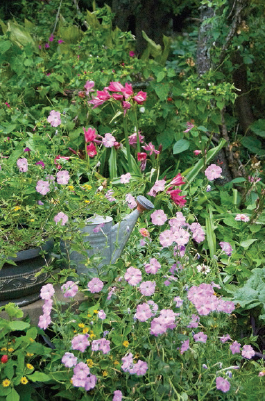
Old-fashioned petunias need a dry space, an unirrigated garden to seed themselves in. Given that, they’ll be a part of your garden for decades.
Another modern habit that discourages most seed germination is to layer heavy mulches everywhere. Preemerge herbicides certainly do, too. In the crinum fields, in recognition of this and to encourage various types of plants, Tom and I use different types of mulches in different areas. In a backfield, old petunias, gomphrena, cleome, gallardia, portulaca, and zinnia seed themselves in every year. There, we don’t mulch heavily and don’t encourage highly organic soils. Those seeds succeed on hot dry soils. In other areas, heavy mulch limits seed germination and encourages crinum growth. Sometimes, it’s all beyond our control, and a crop of cosmos or some weed germinates where we least expect it.
In clients’ gardens, for the same reasons, I aim for various types of mulches. Some plants germinate and seed into gravel or sand or brick. Coriander and fennel seeds will stay in the ground all summer and germinate in the fall, if in the right, gritty mulch. Some plants that rarely seed anywhere will do so in heavy leaf litter mulches. I’ve heard the gibberellic acids from decaying organic matter stimulate otherwise difficult-to-germinate seeds. In new gardens, I’ll often do a perennial planting and then overseed for quick effect. I once planted hundreds of perennial chrysanthemums, a rainbow of colors, using bare root plants. I watered in the new plants, and then spread a very light layer of compost, followed by seeds of zinnia and four-o’clocks. Then I added another layer of compost—just a dusting, and I followed that with another watering. In this garden, the owners already had a pine straw mulch, so to help my seed-in sections integrate, I topped it all with a very light pine straw sprinkle. The first summer, the garden was full of annual color, and the first fall, it was full of mums, perennial marigolds, sweet grass, and other fall flowers that grew under and behind the annuals. The second summer, the seeds “stored” in the ground germinated and made the same display.
They won’t all be successful, though. I once experienced an embarrassing failure when I promised a client a spring meadow of larkspur, but failed to ask her what had happened on the property prior to my involvement. When my first sowing failed, I looked more closely to realize she had no weeds: no chickweed, no vetch, no winter grasses. The former landscaper had applied a seriously heavy layer of preemerge herbicide, which must have had a long residual life and inhibited my seeds.
The use of irrigation systems is another way that you can inadvertently reduce germination. Water has a similar effect as mulch. Many seeds rot in moist conditions, so if you want spring and winter biennials, annuals, and old-fashioned cottage plants, tame the irrigation monster. As we discussed in chapter 4, there are some seeds that like water and will germinate with lots of irrigation, but many of our biennials, our romantic, old flowers of cottage gardens, will rot with too much water.
Nevertheless, I don’t expect full, complete gardens from simply letting everything go to seed; I always supplement by sowing seeds that I’ve saved or bought. Let nature and your notes be the guide for when to sow. Watch for germination, and then fill in where needed. Gardening by letting plants go to seed makes for more fluid cycles of gardening than the imposed spring–summer–fall planting schedule that seems more appropriate for tilled vegetable gardens.
In our crinum farm fields, all sorts of plants seed in, but we are diligent about selecting plants that will complement rather than compete with the main crop. So we have long rows of fennel, dill, and bachelor buttons in spring and peas and peanuts in summer. They all seed themselves in. I’d never put four-o’clocks in there; it’s not just that they’d take over, but also that they have big tubers that would try to grow down, into, and all around our crinum lily bulbs, which is our priority. I imagine the two twisting together, like slugs mating, deforming my perfect ovoid bulbs.
So far, every seed I’ve discussed is from a short-lived, quick-return annual or biennial. But there’s joy in anticipation and caring for seeds that are slow to grow, too. For woody plants, there’s a lot that happens beneath the ground, before you see any top growth. For example, we grow one of our most underappreciated native fruits, the pawpaw tree, which grows easily from seed. After you eat a fruit, store the seed in the fridge for ninety days. As soon as you put that seed in dirt, a root emerges that can grow half an inch each day. In eighteen days, you’ll have a 10-inch root; only then does a little green sprout emerge from the soil. That strong, established root system is what gives seed-grown trees a growth advantage throughout their lives.
Years ago, I met an older woman who captured my imagination by telling me about her garden, on an island in Massachusetts, where all the trees and shrubs were grown from seed. At the time, I didn’t even know they had islands in Massachusetts, much less entire gardens grown from seed collected around the world. Today, Polly Hill Arboretum, the only public botanical garden on Martha’s Vineyard, focuses on collecting seeds from centers of plant diversity. Currently, they’re growing swamp azaleas from seed collected in the Southeast. Director Tim Boland says, “Polly wanted to understand plants and plant growth from the embryonic stage. She wanted to witness the lifecycles of the plants in total. She once said to me, ‘Why would I ever start with a full-grown plant? You miss the teenage years, and after all, they are the most interesting years.’” You can do this, too; these plants will become beautiful markers of time and lovely reminders of events in your life.
My hybrid, Crinum ‘Aurora Glorialis’ took just four years from seed to flower. But then it took another four years in trials before we decided this was worthy of being named to honor my mother, Gloria.
Crinum lilies have become markers of events in my life, and I’ve developed a great and careful system for saving crinum seed, marking dates of each seed set, and monitoring young plants for years. Though not a woody plant, I’ve worked with seeds that will germinate quickly but still take five years or so to mature enough to flower. The seeds of Crinum bulbispermum have entertained me since the mid-1970s.
Crinums are freaks. Crinum seed feel like month-old clay and look like oversized, apple-green macadamia nuts held in a thin, veined sac. The green color should tell you right away that something’s strange here—these seeds photosynthesize. Most seeds are brown and dryish, dormant storage packages. In the wild, many crinum grow in swamps or along rivers. From the minute the seeds drop out of their very masculine sac, they start soaking up the sun and producing their own energy. They might float around or get stuck in the mud immediately, but no matter what, that green skin is producing food the entire time. That amorphous seed does something else strange: wherever it lands, the seed lodges half in, half out of the ground. Remember, it needs the sunlight. The new root starts growing, and the new leaves are formed belowground—both sucking energy from the photosynthesizing seeds. The tiny, white root goes deep. In one place, at just the right depth, a decision (that we still don’t understand) is made: one spot fattens, forming a new bulb the size of a pea. As that little bulb fattens, the seed itself quits producing energy. The new root, bulbs, and leaves suck the remaining life out of the seed. The new leaves finally emerge to start photosynthesizing themselves, feeding the root and building the bulb. The whole process can take a month or many months. From there, it takes four to eight years for that young bulb to flower.
This has been my lifelong seed-saving hobby. I’ve grown thousands and thousands of crinum this way, and of all of those, at least one—okay, maybe two—seemed like an exceptional garden plant, worthy of my naming it, and it took me a dozen years. It was one seed I germinated out of a batch of hundreds. It’s in the group deceptively called Orange River lilies, not because of their color, but because they grow along the banks of the Orange River in South Africa. Distinct from others of its kind, this Crinum bulbispermum opens sort of khaki-green. The next day it fades to pink and by the third day to rich rose—it’s beautiful even in it’s decline. I’ve tested this seedling in varying amounts of light, in different soils, and in combinations with different plants. Perhaps I waited too long to name it, but I’m a gardener who wants only great plants, not just freaks or slight variations or plants that have pretty flowers but flop over. And I wanted this crinum lily to be named to honor my mother, so it had to be right. In the end, we decided to name this special spectrum ‘Aurora Glorialis’.
With flowers and ornamental plants, this is all fun, joyful, rewarding, and practical. The stories, memory banking with seeds, and sleuthing to figure out how to save and germinate can provide you with endless pleasure in the garden. But through it all, we are crucially keeping alive and passing down the understanding of how to grow and how to hybridize seeds. There is real value in understanding how what’s inside a seed relates to the plants we love to grow and what’s in our food. I believe this sort of knowledge needs to be passed on—to our friends and to future generations. If you get into seed saving, if you find yourself obsessed with one freakish seed, then share that passion with your friends and family. They’ll share that knowledge with theirs, and we’ll keep passing it down.
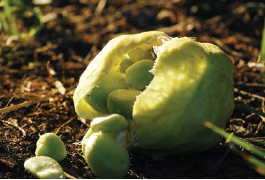
Unlike most seed, crinum seed produce their own energy, photosynthesizing sunlight in their green skins.
To start breeding your own strain, choose one of those types of plants and beg, borrow, or buy a diverse group of varieties. You can choose varieties with complementary strengths and weaknesses, say a very vigorous viola with a limited color range and another with colors you like that doesn’t grow as well. Or, you can just get a bunch of different things and see what happens when their genes mix up. Planting your different varieties close together will encourage cross-pollination.
Then you just let the bees have at it. If you want, you can help out by moving pollen from one flower to another with a paintbrush or even your finger. For plants that self-sow reliably in your garden, you can just let the seeds fall where they will, and the next generation will spring up all by itself. Or collect the seeds and sow them out yourself. Remember, the more plants you grow, the more beautiful things you’ll have to choose from, so more is always better!
As the next generation grows, look them over. Save the ones that grow the best, flower the most, and are the prettiest, and pull out the rest. Be a little ruthless here! Saving just the prettiest, healthiest, plants will make your next generation even better. Keep doing this year after year, and each season the plants will become better adapted to your climate and garden, and more beautiful!
You can also always add new varieties with a new color, fragrance, or form to the mix to keep spicing things up.
Joseph knows about diversity. As nursery manager at Arrowhead Alpines Rare Plants Nursery, he manages hundreds of variations of common and rare plants, like the somewhat common but underappreciated Clematis integrifolia. When you do see it for sale, you usually see the same old, one variety. Joseph maintains and loves at least ten different varieties, which reminds us how detailed, intense, and fun horticulture used to be and should be again.